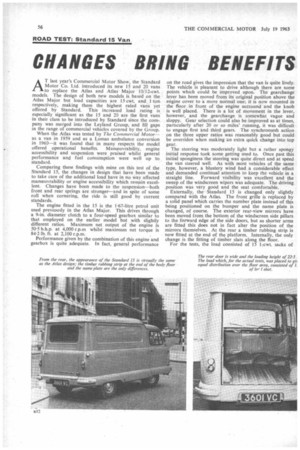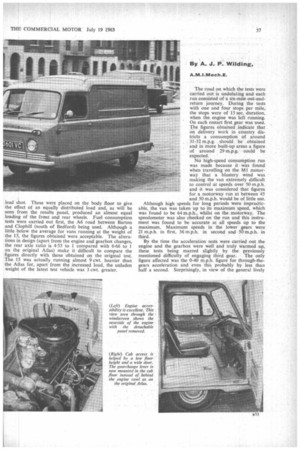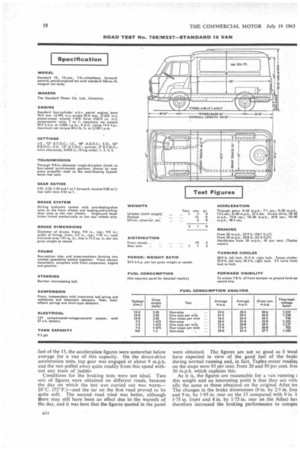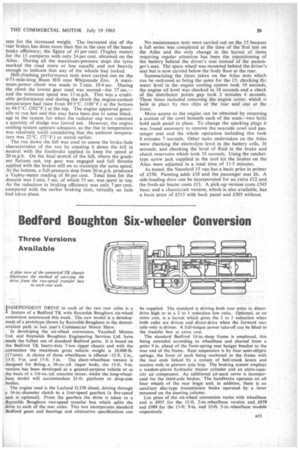CHANGES BRING BENEFITS
Page 58

Page 59

Page 60

Page 61

If you've noticed an error in this article please click here to report it so we can fix it.
AT last year's Commercial Motor Show, the Standard Motor Co. Ltd. introduced its new 15 and 20 vans to replace the Atlas and Atlas Major 10/12-cwt. models. The design of both new models, is based on the Atlas Major but load capacities are 15 cwt. and 1 ton. respectively, making them the highest rated vans yet offered by Standard. This increased load rating is. especially significant as the 15 and 20 are the first vans in their class to be introduced by Standard since the company was merged into the Leyland Group, and fill gaps in the range of commercial vehicles covered by the Group.
When the Atlas was tested by The Commercial Motor— as a van in 1959 and as a Lomas ambulance conversion in 1960—it was found that in many respects the model offered operational benefits. Ma nceuvrability, engine accessibility and suspension were praised whilst general performance and fuel consumption were well up to standard.
Comparing these findings with mine on this test of the Standard 15, the changes in design that have been made to take care of the additional load have in no way affected manceuvrability or engine accessibility which remain excellent. Changes have been made to the suspension—both front and rear springs are stronger—and in spite of some roll when cornering, the ride is still good by current standards.
The engine fitted in the 15 is the 1.67-litre petrol unit used previously in the Atlas Major. This drives through a 9-in, diameter clutch to a four-speed gearbox similar to that employed on the earlier model but with slightly different ratios. Maximum net output of the engine is 5t15 b.h.p. at 4,000 r.p.m whilst maximum net torque is 84.2 lb. ft. at 2,100 r.p.m. , Performance given by the combination of this engine and gearbox is quite adequate. In fact, general performance on the road gives the impression that the van is quite lively. The vehicle is pleasant to drive although there are some points which could be improved upon. The gearchange lever has been moved from its original position above the engine cover to a more normal one; it is now mounted in the floor in front of the engine surround and the knob is well placed. There is a lot of movement in the lever, however, and the gearchange is somewhat vague and sloppy. Gear selection could also be improved as at times, particularly after 20 or so miles' running, it was difficult to engage first and third gears. The synchromesh action on the three upper ratios was reasonably good but could be overriden when making an extra quick change into top gear.
The steering was moderately light but a rather spongy initial response took some getting used to. Once past this initial sponginess the steering was quite direct and at speed the van steered well. As with most vehicles of the same type, however, a blustery wind had ,a considerable effect and demanded continual attention to keep the vehicle in a straight line. Forward visibility was excellent and the sweep of the windscreen wipers was adequate. The driving ,position was very good and the seat comfortable. Externally, the. Standard 15 is changed only slightly compared with the Atlas. The front grille is replaced by a solid panel which carries the number plate instead of this being positioned on the bumper and the name plate is changed, of course. The exterior rear-view mirrors' have been moved from the bottom of the windscreen side pillars to the forward edge of the side doors, but as shorter arms are fitted this does not in fact alter the position of the mirrors themselves. At the rear a timber rubbing strip is now fitted at the end of the platform. Internally, the only change is the fitting of timber slats along the floor.
For the tests, the load consisted of 15 1:cwt. sacks of
lead shot. These were placed on the body floor to give the effect of an equally distributed load and, as will be seen from the results panel, produced an almost equal loading of the front and rear wheels. Fuel consumption tests were carried out first, the A6 road between Barton and Clophill (south of Bedford) being used. Although a little below the average for vans running at the weight of the 15, the figures obtained were acceptable. The alterations in design (apart from the engine and gearbox changes, the rear axle ratio is 4-55 to 1 compared with 6-66 to I on the original Atlas) make it difficult to compare the figures directly with those obtained on the original test. The 15 was actually running almost 9 cwt. heavier than the Atlas for, apart from the increased load, the unladen weight of the latest test vehicle was 3 cwt. greater. The road on which the tests were carried out is undulating and each run consisted of a six-mile out-andreturn journey. During the tests with one and four stops per mile, the stops were of 15 sec. duration, when the engine was left running. On each restart first gear was used. The figures obtained indicate that on delivery work in country districts a consumption of around 31-32 m.p.g. should be obtained and in more built-up areas a figure of around 29 m.p.g. could be expected.
No high-speed consumption run was made because it was found when travelling on the M1 motorway that a blustery wind was making the van extremely difficult to control at speeds over 50 m.p.h. and it was considered that figures for a motorway run at between 45 and 50 m.p.h. would be of little use.
Although high speeds for long periods were impracticable, the van was taken up to its maximum speed, which was found to be 64 m.p.h., whilst on the motorway. The speedometer was also checked on the run and this instrument was found to be accurate at all speeds up to the maximum. Maximum speeds in the lower gears were 21 m.p.h. in first, 36 m.p.h. in second and 50 m.p.h. in third.
By the time the acceleration tests were carried out the engine and the gearbox were well and truly warmed up, these tests being marred slightly by the previously mentioned difficulty of engaging third gear. The only figure affected was the 0-40 m.p.h. figure for through-thegears acceleration and even this probably by less than half a second. Surprisingly, in view of the general lively feel of the 15, the acceleration figures were somewhat below average for a van of this capacity. On the direct-drive acceleration tests, top gear was engaged at about 9 m.p.h. and the van pulled away quite readily from this speed without any trace of judder.
Conditions for the braking tests were not ideal. Two sets of figures were obtained on different roads, because the day on which the test was carried out was warm20°C. (72°E.)—and the tar on the first road proved to be quite soft. The second road tried was better, although there may still have been an effect due to the warmth of the day, and it was here that the figures quoted in the panel were obtained. The figures are not so good as I woul have expected in view of the good feel of the brakt during normal running and, in fact, Tapley-meter readinl on the stops were 93 per cent. from 20 and 95 per cent. froi 30 m.p.h. which explains this. As it is, the figures are reasonable for a van running this weight and an interesting point is that they arc virtt ally the same as those obtained on the original Atlas tes The changes in the brake dimensions (9 in. by 2-5 in. fro' and 9 in. by 1.95 in. rear on the 15 compared with 9 in. 1.75 in. front and 8 in. by 1-75 in. rear on the Atlas) hal therefore increased the braking performance to compel sate for the increased weight. The increased size of the rear brakes has done more than this in the case of the handbrake efficiency; the figure of 43 per cent. (Tapley meter) for the 15 compares with only 24 per cent, obtained on the Atlas. During all the maximum-pressure stops the tyres marked the road more or less equally and not heavily enough to indicate that any of the wheels had locked.
Hill-climbing performance tests were carried out on the 0.75-mile-1ong Bison Hill near Whipsnade Zoo. A maximum-power climb was made in 2 min. 10-4 sec. During the climb the lowest gear used was second—for 57 sec.— and the minimum speed was 15 m.p.h. This was a creditable performance and during the climb the engine-coolant temperature had risen from 89.5°C. (188°F.) at the bottom to 94.5°C. (202°F.) at the top. The engine appeared generally to run hot and this may have been due to some blockage in the system for when the radiator cap was removed a quantity of sludge was forced out. However, the engine cooling system appears adequate, as the rise in temperature was relatively small considering that the ambient temperature was 22°C. (72°F.) as stated earlier.
The run down the hill was used to assess the brake-fade characteristics of the van by coasting it down the hill in neutral with the footbrake applied to keep the speed at 20 m.p.h. On the final stretch of the hill, where the gradient flattens out, top gear was engaged and full throttle applied with the brakes still on to maintain the same speed. At the bottom, a full-pressure stop from 20 -m.p.h. produced a Tapley-meter reading of 86 per cent. Total time for the descent was 3 min. 5 sec. of which 55 sec. was spent in top. As the reduction in braking efficiency was only 7 per cent. compared with the earlier braking tests, virtually no fade had taken place.
No maintenance tests were carried out on the 15 because a full series was completed at the time of the first test on the Atlas and the only change in the layout of items requiring regular attention has been the repositioning of the battery behind the driver's seat instead of the passenger's seat. The spare wheel was mounted behind the driver's. seat but is now carried below the body floor at the rear.
Summarizing the times taken on the Atlas tests which can be reckoned as being the same for the 15: checking the water level in the engine cooling system took 19 seconds, the engine oil level was checked in 18 seconds and a check of the distributor points gap took 2 minutes 4 seconds. These times included removing the engine cover, which is held in place by two clips at the rear and one at the front.
More access to the engine can be obtained by removing a section of the cowl beneath each of the seats—two bolts hold each panel in place. To change the sparking plugs it was found necessary to remove the nearside cowl and passenger seat and the whole operation including this took 8 minutes 7 seconds. Other tasks undertaken on the Atlas were checking the electrolyte level in the battery cells, 36 seconds, and checking the level of fluid in the brake and clutch reservoirs which took 35 seconds. Using the ratchettype screw jack supplied in the tool kit the brakes on the Atlas were adjusted in a total time of 11.5 minutes.
As tested. the Standard 15 van has a basic price in primer of £550. Painting adds £18 and the passenger seat £6. A side-loading door can be incorporated for an extra £12 and the fresh-air heater costs £13. A pick-up version costs £545 basic and a chassis/cab version, which is also available, has a basic price of £515 with back panel and £505 without.




















































































































